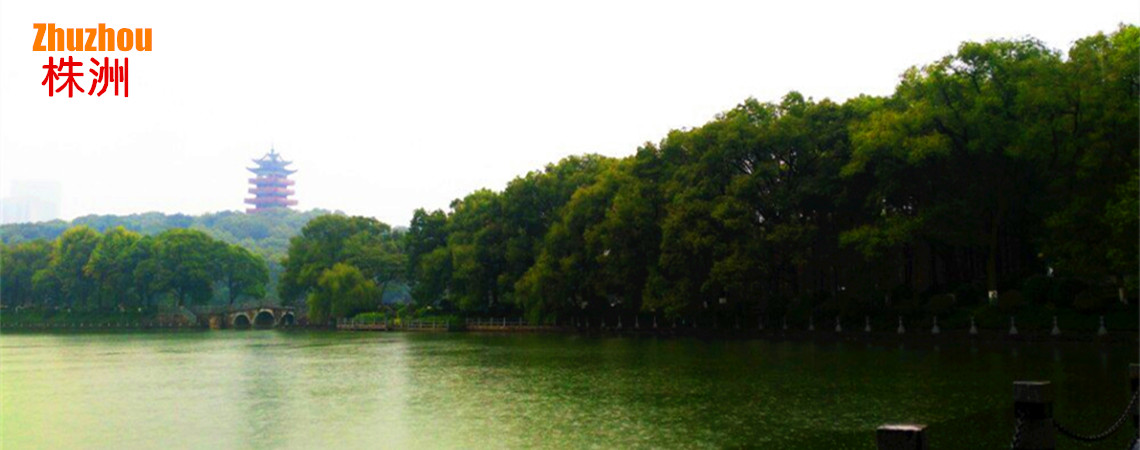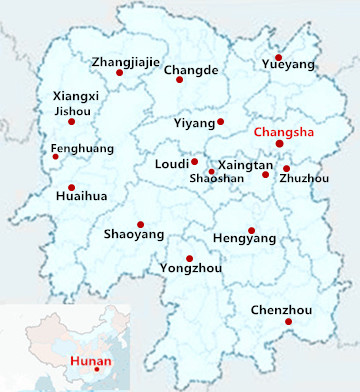
Zhuzhou Overview
 Zhuzhou, formerly Jianning, is a city in Hunan Province, China, southeast of Changsha beside the Xiangjiang River. It is part of the "ChangZhuTan Golden Triangle" (comprising the cities of Changsha, Zhuzhou and Xiangtan). Zhuzhou is located in a subtropical monsoon climate zone and with its abundant mineral and organic resources has one of the highest agricultural yields in Hunan Province. Zhuzhou is a new industrial city, about 50 km from Changsha, and the largest transport hub south of the Yangtze River.During the processing of development in new century, the municipal party commission and government is implementing the striding development strategy. We welcome from our hearts friends home and abroad come to Zhuzhou to visit, invest and develop. Let's build Zhuzhou's glorious future band in hand!
Zhuzhou, formerly Jianning, is a city in Hunan Province, China, southeast of Changsha beside the Xiangjiang River. It is part of the "ChangZhuTan Golden Triangle" (comprising the cities of Changsha, Zhuzhou and Xiangtan). Zhuzhou is located in a subtropical monsoon climate zone and with its abundant mineral and organic resources has one of the highest agricultural yields in Hunan Province. Zhuzhou is a new industrial city, about 50 km from Changsha, and the largest transport hub south of the Yangtze River.During the processing of development in new century, the municipal party commission and government is implementing the striding development strategy. We welcome from our hearts friends home and abroad come to Zhuzhou to visit, invest and develop. Let's build Zhuzhou's glorious future band in hand!Chinese Name: 株洲 (zhū zhōu)
Location: east of Hunan Province
Population: 4,020,800(2018)
Area: 11,262 square kilometers
Nationalities: Han
Administrative: Zhuzhou City has 5 districts (Tianyuan, Lucheng, Hetang, Shifeng, and Qiaokou), 3 counties (Youxian, Chaling County, and Yanling County), 1 county-level City( Liling City)and 1 county-level demonstration area (Yunlong).
Zhuzhu History
Zhuzhou is a time-honored city. In the early 1980s, ruins of four and six thousand years ago were discovered here. One of the primogenitors of Chinese nation and the initiator of Chinese agrarian culture, Yan Emperor, is at the rest in Yanling County. Jianning is the old name of the city, and the name of Zhuzhou was initially used in the Southern Song Dynasty (1127-1279). During the initial post-liberation period, Zhuzhou is just a small town under Xiangtan, but the city now is a big city of Hunan with millions of population.
Geography of Zhuzhou
The city is situated in the east of Hunan Province, on the middle reaches of the Xiangjiang River. It is bordered by Jiangxi Province in the east. Changsha, the capital city of the province, is adjacent to its north, only 50 kilometers (31 miles) far away. Together with Changsha and Xiangtan, they constitute the most important economic development zone of Hunan.
The region has a typical hilly landform with the terrain generally slopes downwards from southeast to northwest. The Xiangjiang River winds south-north through the city. On the whole, plain and hill make up the main components of Zhuzhou's territory...More
Zhuzhu Climate
This region is definitely a fertile land enjoying favorable humid monsoon climate in subtropical zone. The annual average temperature falls between 16 and 18 degree centigrade (60.8 and 64.4degree Fahrenheit).
Zhuzhou Economy
Zhuzhou is the second largest city in Hunan Province, and it's an industrial city with four key industries are metallurgy, machine manufacture, chemicals and building materials. Zhuzhou became one of the eight key national-wide industrial cities in the 1st Five-Year-Plan. 4 out of 156 key projects were set up in Zhuzhou. Later on, more than 20 important factories were built in Zhuzhou. Zhuzhou's high-tech industrial development zone was approved by the State Council in December 1992 and was designated in a 35 km² area next to the Xiangjiang River.
There are many good quality and key industrial products produced in this city, such as Electrical Locomotives, Motorcycles, Nonferrous Metals, Fertilizers, Chemicals and Cemented Carbide. Siemens, Yamaha, Mitsubishi and many other multinational companies have invested in Zhuzhou. It has one national level Economic Development Zone and several provincial level development areas. Nowaday, companies with long-sight strategy started learning and developing their own technological barriers.
Zhuzhou Tourism
It is not a tourist city with any notable landmarks. Visitors may want to spend time visiting YanKing Square (named for Shen Nong) with it's sweeping views of Zhuzhou and large statue paying tribute to this legendary figure. Much of the areas beauty was destroyed by the new factories that were erected to produce mass amounts of steel and other industrial commodities.






 Ask Questions ?
Ask Questions ?